
How have the jersey sponsors changed since the early 1990s?
From local food companies to multinationals: the evolution of the sponsorships is total
August 7th, 2019
What would the football world be like without the jersey sponsors? We struggle so hard to imagine it, in 2019, that perhaps it is better to leave the matter alone, even if a few days ago Joe.co.uk imagined what all this would be like, a real shock. The invasion of the brands is practically unstoppable, given that now in Italy we are used to seeing them everywhere: on the sleeves, in the back of the shirts and on the shorts, just as has been happening for some time in the Japanese or French leagues, where the football shirts are really filled of different badges. For example, have you read about the 10 sponsors on the Chambly jersey, necessary for the survival of the small transalpine club? Quite the opposite of 'virgin' kits, those that were more frequent to see a few years ago but which are now a real rarity.

Speaking of sponsors, on Twitter we have just come across a very interesting infographic published by the account of Classic Football Shirts: the English world leader in the football shirts' sale compared, in fact, the situation of the sponsors in the 2019/2020 Premier League seasonto that of 1992/1993, the first season of new era of the British top flight. The difference, of course, is huge: what immediately catches the eye is the massive presence of the betting companies (almost all foreign, moreover), which sponsor 50% of the clubs. A fact that does not surprise us at all, given that in this regard we had recently talked about it both in the case of the Paddy Power campaign for Huddersfield Town and also when we analyzed the profits of Premier teams deriving from sponsorship contracts. In Italy it's no longer possible to see them: it's what has been regulated by the so-called 'dignity decree' which will come into force on 8 August and which will, in fact, keep betting and gambling companies far from all footballing events and that, among many other things, forced AS Roma to give up a rich contract with Betway and Lazio to conclude the relationship with its main sponsor, Marathonbet.
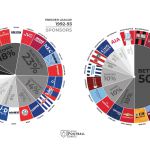
The pie diaphragm is a fair image, and immediately led us to think about what was happening in Italy: almost 30 years have passed since that Serie A season won by AC Milan, in which Beppe Signori (in his first year at Lazio) won the top-scorer ranking while Parma arrived in front of Juventus. The protagonists were Savicevic, Vialli, Zola, Gascoigne and Schillaci and Marcello Lippi was still Atalanta manager. But let's dwell on the jersey sponsors, the vast majority of which are Italian food companies that have made some epic kits thanks to unforgettable partnerships: that of Roma with Barilla, that of Juventus with Danone, that of AC Milan with Motta and that of Napoli with Voiello, to give some examples. In fact, it's often thanks to the sponsors that we have become attached to one shirt rather than another, conditioned in one way or another by the writing put on display, on the chest: a distinctive sign much more powerful than the intrinsic details such as the color or type of collar. The list is practically endless, and subjective of course: would we still remember the Napoli shirt without the Mars sponsor or that of Inter Milan hadn't been there without the word Misura on it?
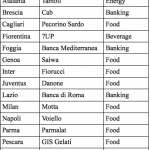
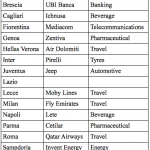
A trend, that of the local companies that associate their names to the Serie A clubs, which has gone increasingly fading to the present day. From the entrance on the scene of great international giants such as Sony (Juventus) and Opel (Milan) to the present day is a moment: in the Serie A 2019/2020 only two teams will have on their shirts of the companies producing drinks as main sponsor, respectively Cagliari with the local beer Ichnusa and Napoli, with Lete water. The rest is divided fairly evenly between automotive and related companies (in addition to Jeep, Dacia and Suzuki, there is the historic Inter partner, Pirelli) and companies in the tertiary sector of all kinds; there are very few foreign companies, while the most representative category is made up of the so-called travel companies: AC Milan and AS Roma, in fact, are linked to big airline companies like Qatar Airways and Fly Emirates, while the two newly promoted Lecce and Verona are joined by two local companies: Moby Lines and Air Dolomiti. Virtually totally extinct, we can say, the case of the 'president's football team', or when the club becomes the main, or secondary, asset of the owner's company, organized as a family business: such situations occur only in the province in the emblematic case of the Squinzi's Sassuolo, the MAPEI boss, and partly also as regards SPAL and Atalanta, the two teams that reflect the interests of the two owners, Mattioli and Percassi.
It's mainly the sponsors' revenues that give the true dimension of the gap that exists between the teams of the same league, which is increasingly broader year after year. If Jeep pours out something like 18 million euros per season in the Bianconeri coffers, direct competitors are not far away, on the contrary: in 2014 AC Milan signed a 100 million contract in 5 years with Fly Emirates, while AS Roma after having been for years without any jersey sponsors has signed a three-year deal with Qatar Airways for a total of about 40 million euros. Inter takes over 10 from Pirelli, but there must also be considered a practically similar figure collected by Suning: among the total earnings the big clubs in fact are not limited to the main sponsors but manage to obtain large sums even from less significant sponsors, co-sponsor and sleeve sponsor, a novelty of the recent years. A striking example is that of Napoli, which adds MSC Crociere and Kimbo to Lete.
The difference with the British first division, however, remains enormous: once again the graphics of Classic Football Shirts are providential in this sense and highlight the abyss that exists not only between the Serie A and Premier League but also the internal gap between the twenty English clubs, and even more precisely between Manchester United (£64mln) and Brighton (£1,5mln). In Italy, however, it's practically impossible to go back to precise data, given that many agreements are recent and not at all transparent: in all probability, the newly promoted Lecce will occupy the bottom role of this special ranking: the Giallorossi, who as a technical supplier have relied on a home made brand like M908, a year ago received just 250,000 euros per season from Moby Lines, a figure that was only slightly replenished following the promotion to top flight and and which is close to the one perceived by Empoli last year, 500,00 euros thanks to the partnership with Computer Gross.
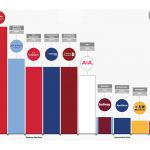
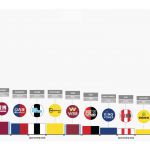








































.png)


.jpg)



.jpeg)











.jpeg)
.jpeg)
.jpeg)



























































